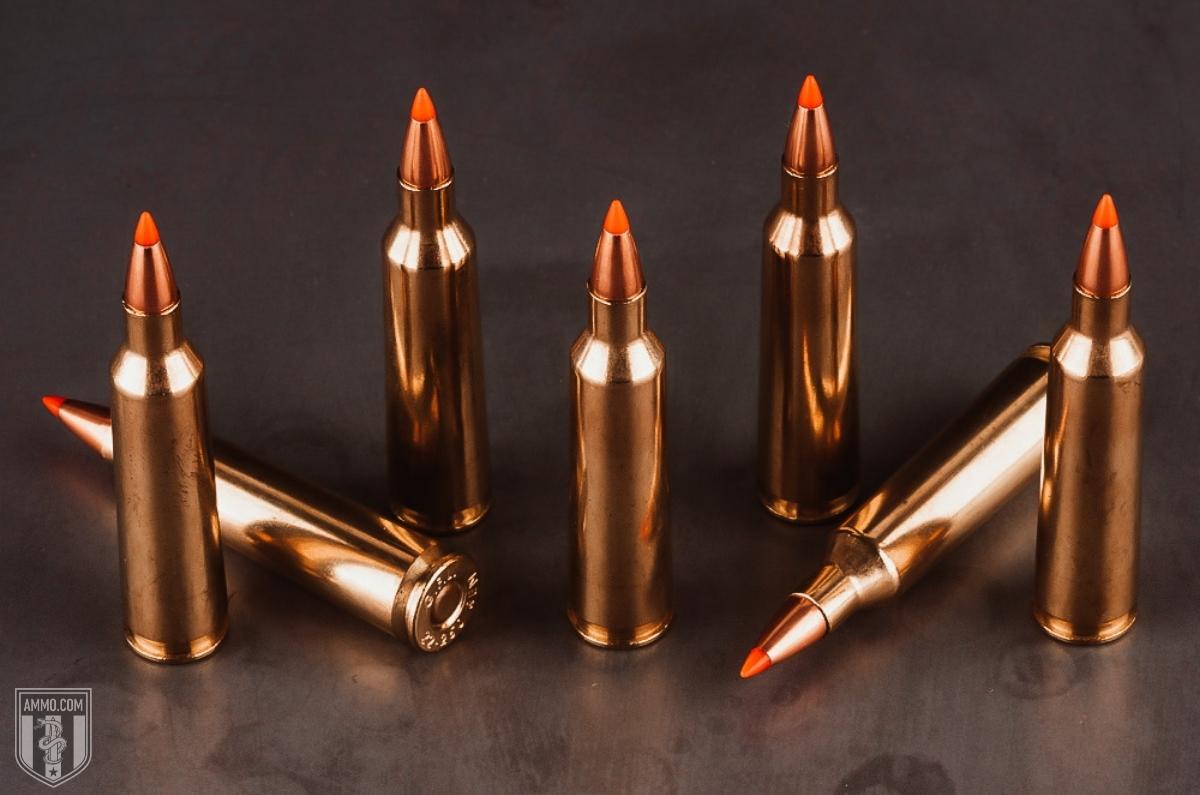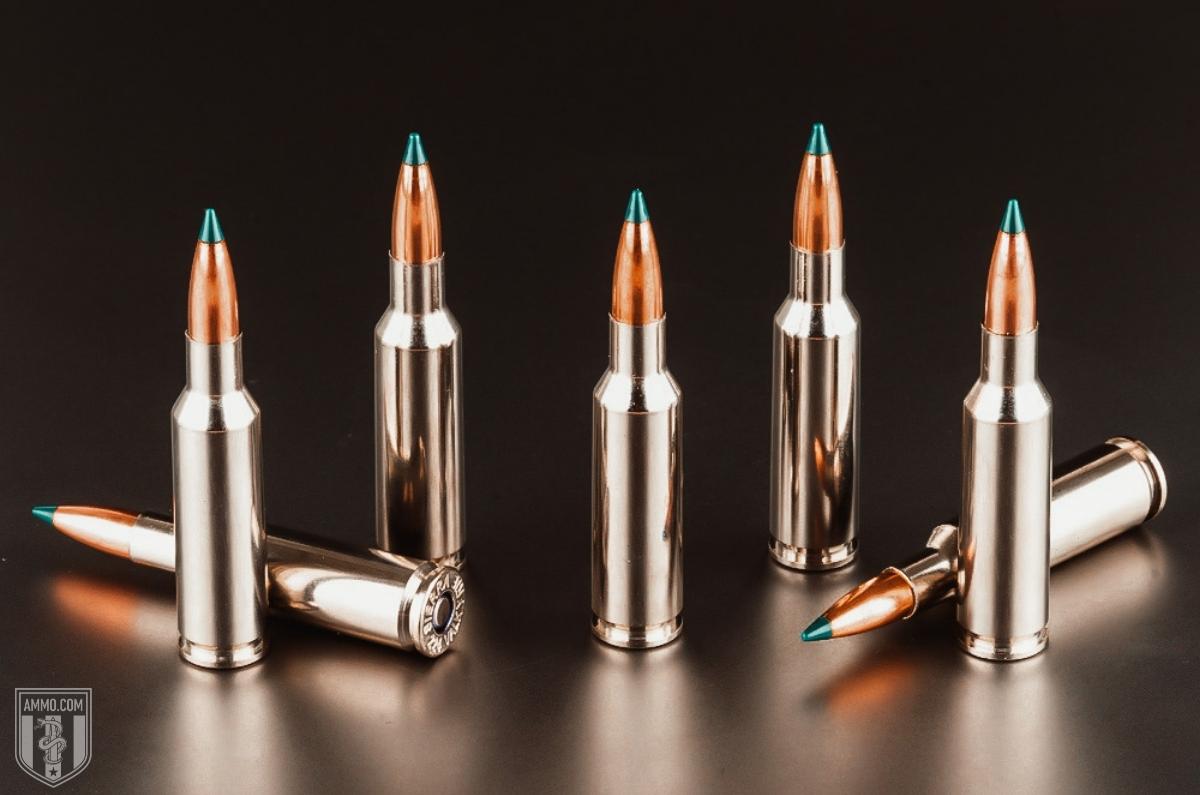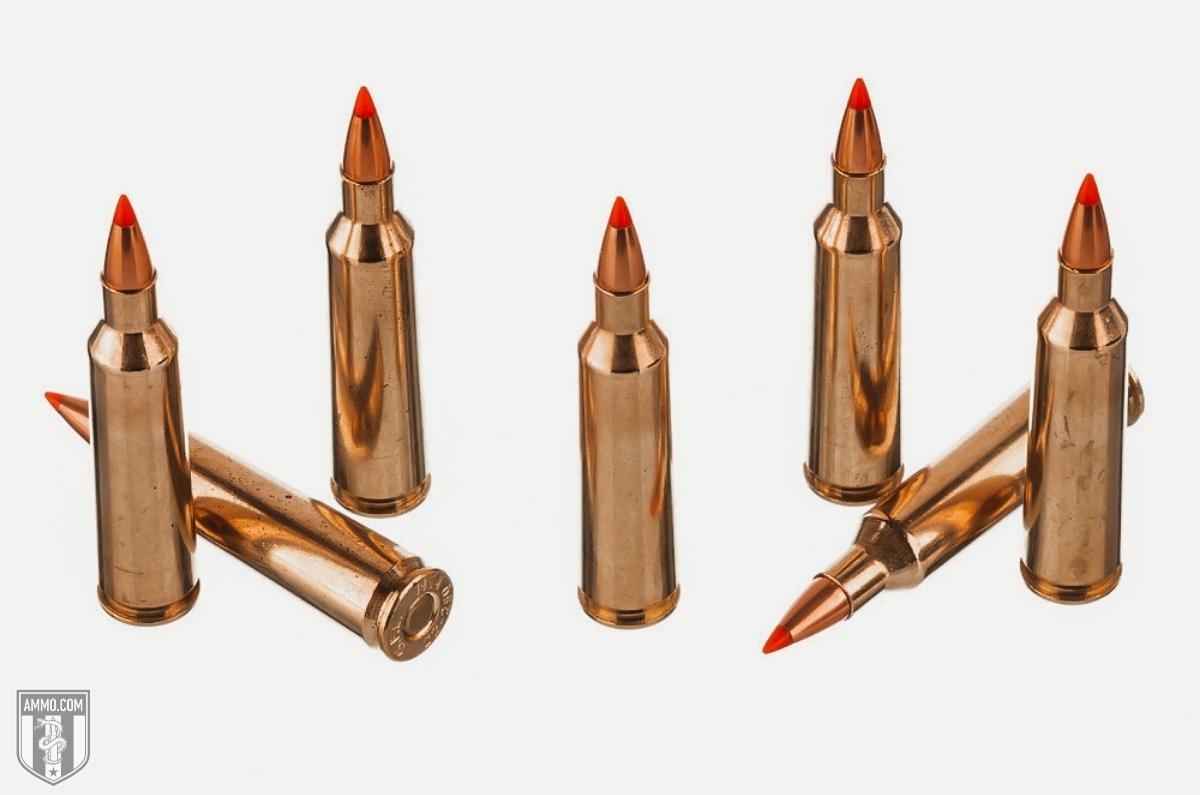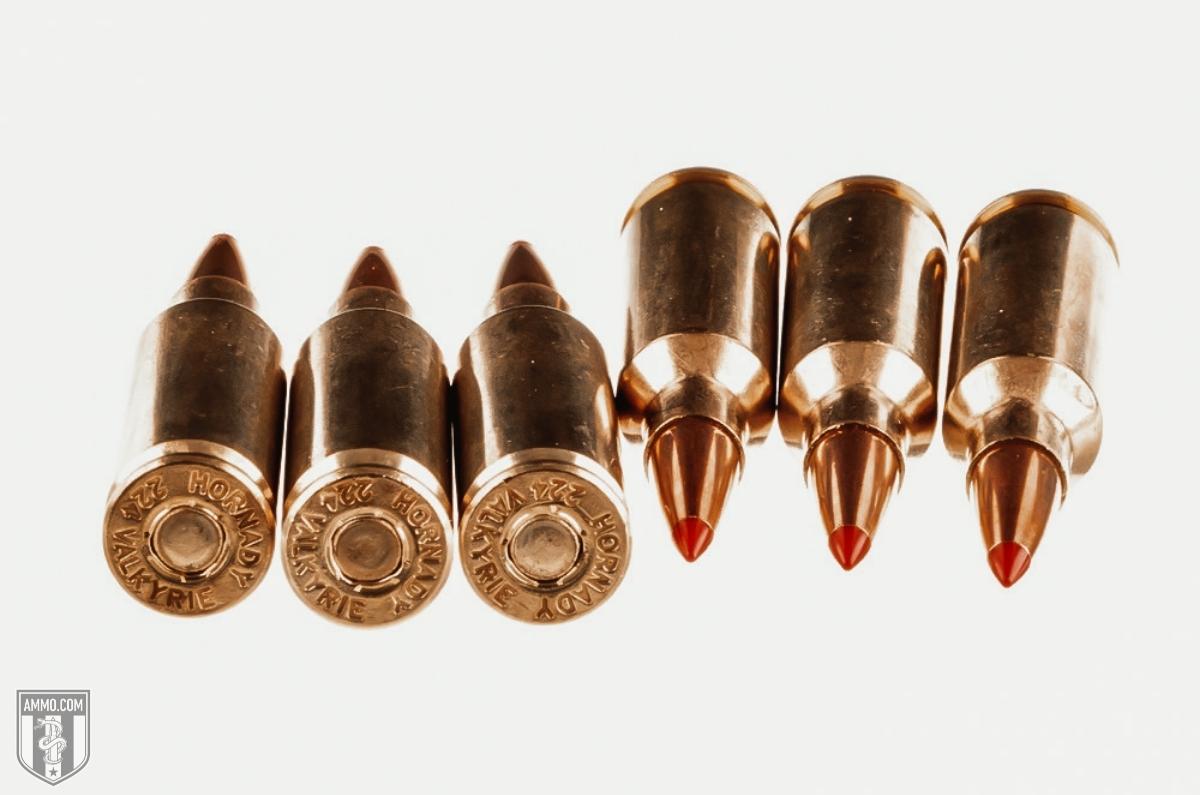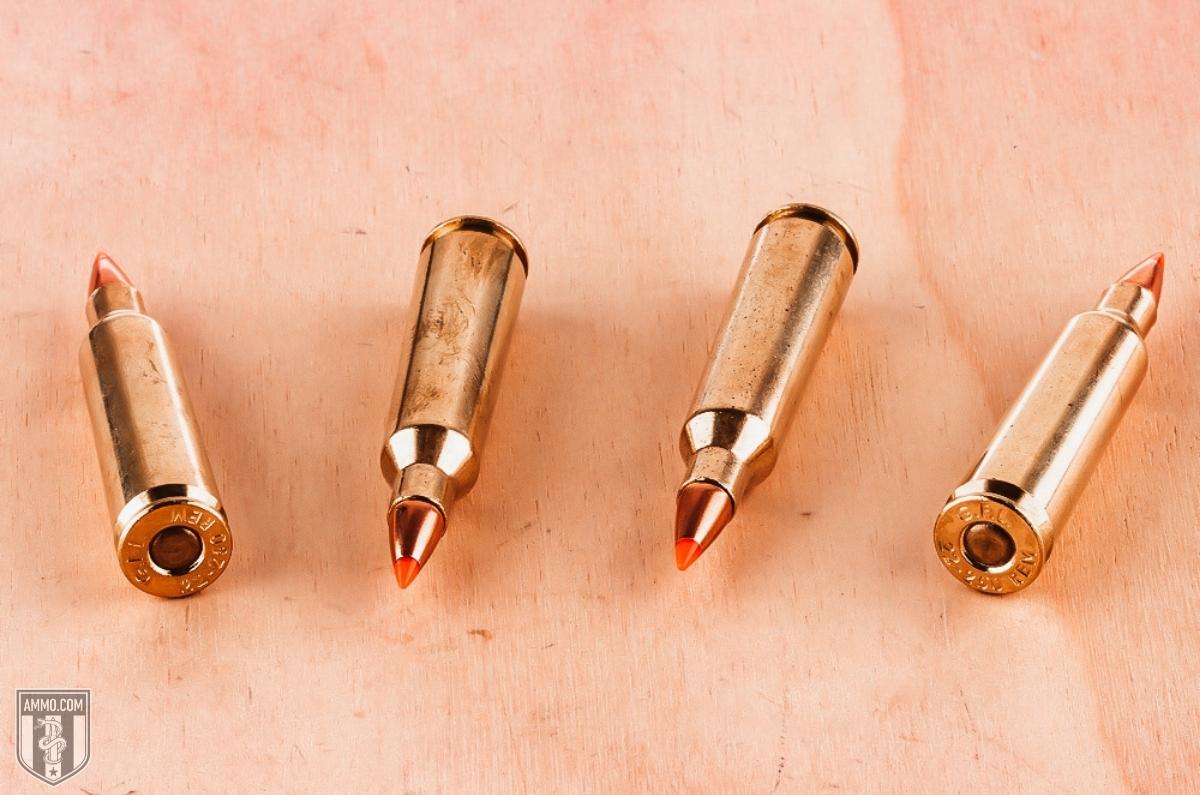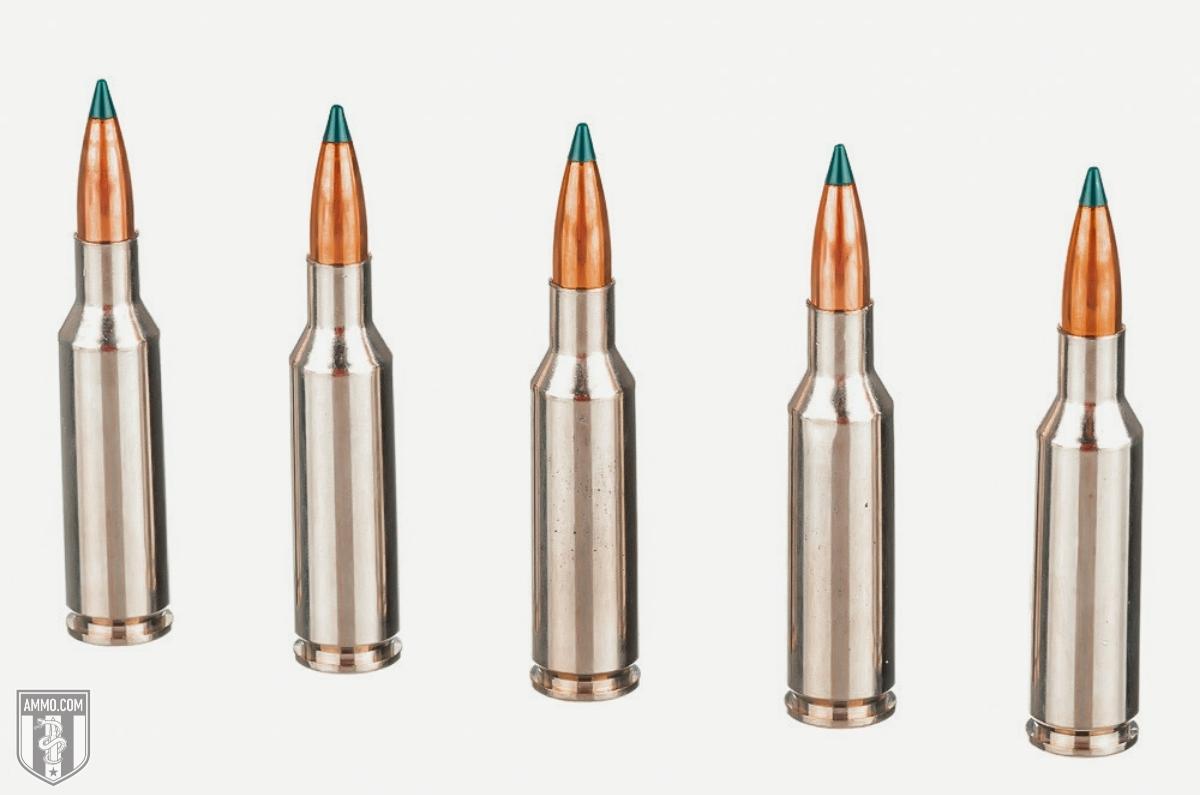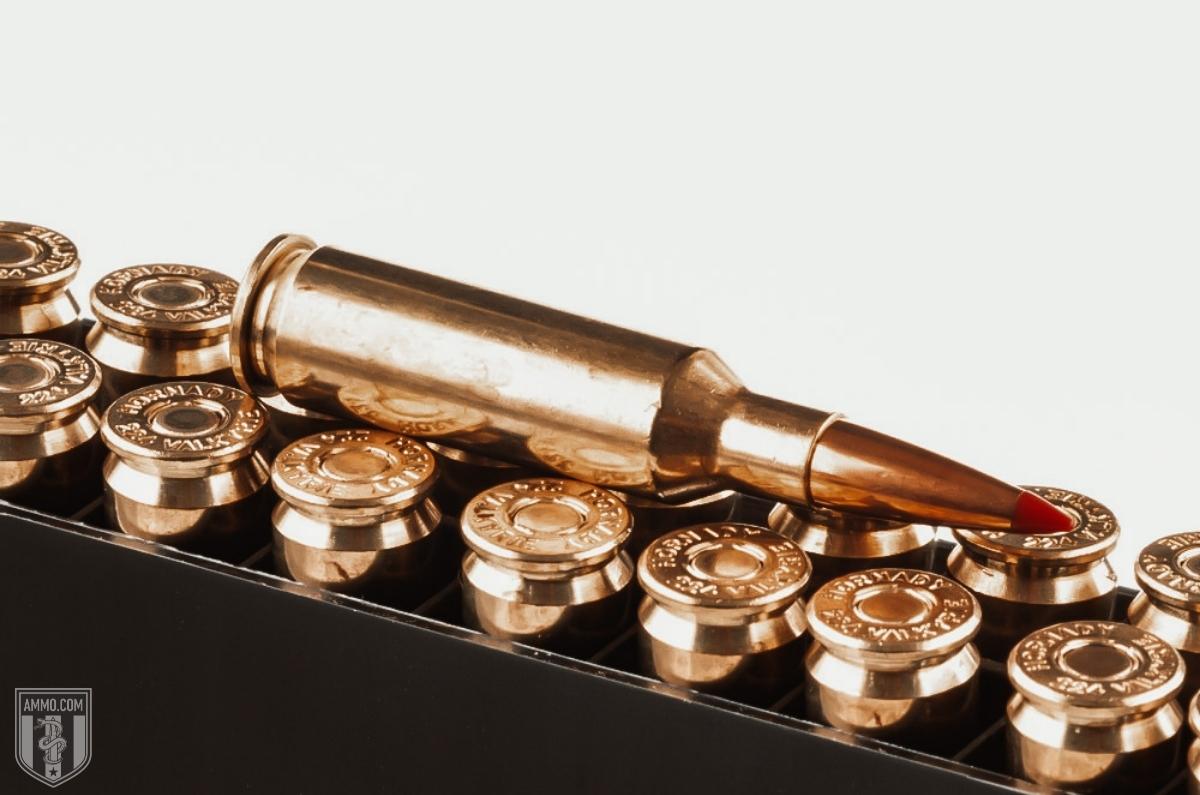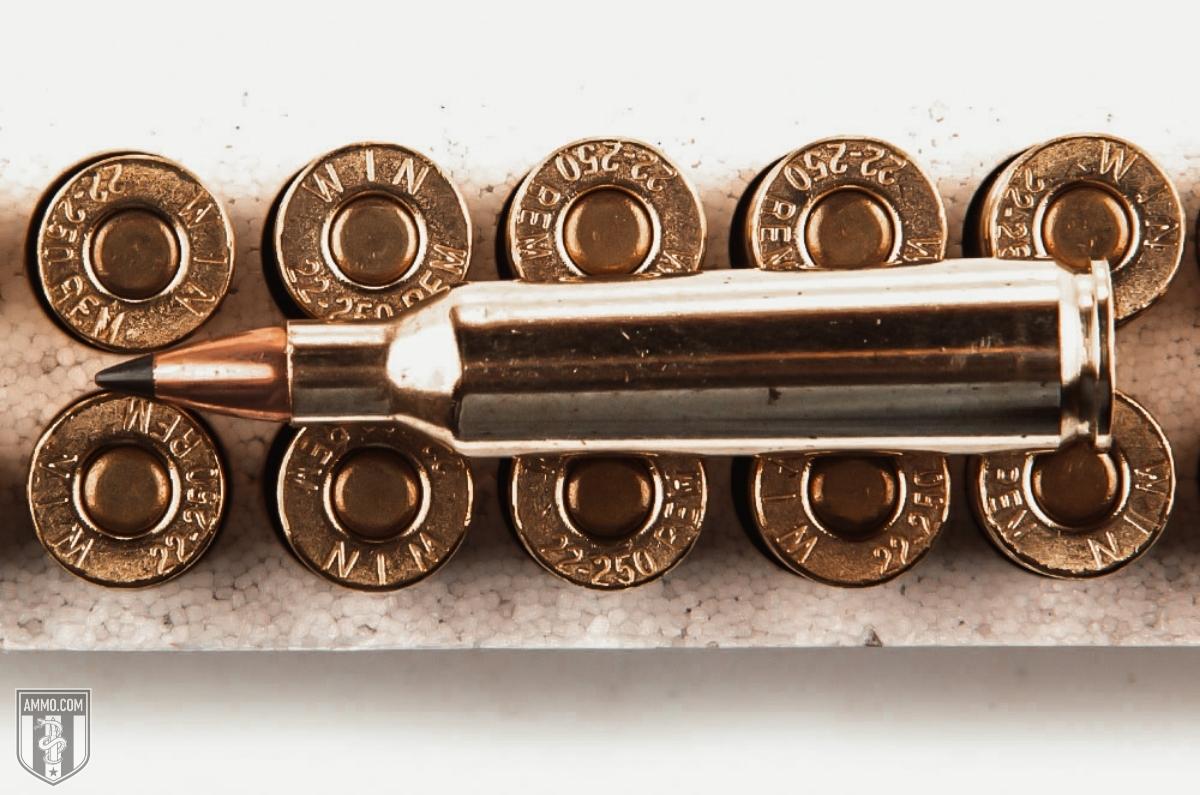224 Valkyrie vs 22-250: Send the Varmints To Valhalla
 The 224 Valkyrie and 22-250 Remington are two centerfire 22 caliber rifle cartridges that excel at long range accuracy and varmint control. The decision over which cartridge is superior primarily circles around which rifle system you prefer: the semi-auto AR-15 or bolt-action rifles.
The 224 Valkyrie and 22-250 Remington are two centerfire 22 caliber rifle cartridges that excel at long range accuracy and varmint control. The decision over which cartridge is superior primarily circles around which rifle system you prefer: the semi-auto AR-15 or bolt-action rifles.
The 22-250 Rem is the older of the two and is typically relegated to bolt guns. It has been a mainstay varmint hunting cartridge since its release in 1965 and is considered the second fastest 22 caliber cartridge on the market.
The 224 Valkyrie is a relatively new cartridge that was released in 2018 to compete with the 22 Nosler. Designed to be fired from the AR-15 platform, the 224 Valkyrie offers marksmen a soft-shooting semi-automatic rifle that can maintain MOA level accuracy out to 1,300 yards.
With its extended range, does this mean that the 224 Valkyrie is superior to the stalwart 22-250 Remington?
In this article we will explore the advantages and disadvantages of both rifle cartridges to help you decide which one is better suited for your shooting and pest control needs.
What is the Difference Between 224 Valkyrie and 22-250?
The difference between 224 Valkyrie and 22-250 Remington is their effective range and the bullet weights they fire. The 224 Valkyrie was designed to shoot heavier bullets up to 1,300 yards while the 22-250 excels at firing lighter bullets at ranges below 1,000 yards.
Cartridge Specs
When evaluating two long range precision rifle cartridges, it’s a good idea to analyze the cartridge specs to gain more knowledge of each.
The first thing to note is that both the 22-250 and 224 Valkyrie fire the same 22 caliber bullets, however the bullet weight each one was developed to fire is drastically different. The 224 Valkyrie was designed around firing the 90 gr Sierra Matchking bullet while the 22-250 Rem focuses on lighter varmint slaying bullets between 34 and 64 grains.

The next major difference is the case length, as the 22-250 is approximately 0.31” longer than the 224 (1.912” vs 1.60”, respectively). This directly relates to the intended rifle each cartridge is designed to be used in. The 22-250 is predominantly used in a bolt-action rifle while the 224 Valkyrie was designed for semi-auto fire in an AR-15 platform. If the 224 cartridge case were any longer, it would require the use of an AR-10 receiver which would add additional cost to the shooter.
Thas the 22-250 Remington has a longer case, it naturally has a higher case capacity than the 224 Valkyrie by almost a 30% margin. The 22-250 has a case capacity of 44.6 grains of H20 while the 224 comes in at 34.5 grains.
Although the cartridge length is considerably different between the two rifle cartridges, they have almost identical overall lengths. This difference is due to the cartridge and chamber design for both rifle cartridges, as the 224 Valkyrie was built to easily seat longer, heavier bullets while the 22-250 was designed for firing lighter bullets at extremely high muzzle velocity (FPS).
The SAAMI maximum chamber pressure is almost identical for both cartridges, however the 224 Valkyrie is rated to handle 2,000 psi more than the 22-250 (55,000 vs 53,000 psi, respectively).
Recoil
In terms of recoil, both rifle cartridges are virtually identical. The 224 Valkyrie will have on average around 6.5 ft-lbs of recoil energy while the 22-250 will comes in around 6.7 ft-lbs. It’s unlikely that most shooters will be able to tell the difference between the two.
However, one major difference is how each host rifle handles recoil. Since the AR-15 platform operates using semi-automatic fire, it has a built-in recoil reduction system and recoil buffer to help soften felt recoil.
On the other hand, the 22-250 is typically fired from a bolt-action rifle that will impart all the recoil energy into the shooters shoulder, though a recoil pad can help.
However, most shooters will not feel that either cartridge is overly oppressive in terms of recoil, and both are described as being easy on the shoulder.
Trajectory
Trajectory is how we quantify a bullet’s flight path as it travels downrange measured in inches of bullet drop.
Obviously, a flatter shooting cartridge is preferred for shooting longer ranges, as a shooter will require fewer adjustments to their optics to compensate for bullet drop. Having a flatter trajectory also means that a cartridge will be more forgiving of ranging mistakes.
The 22-250 Rem is well known for having one of fastest muzzle velocities of cartridges currently available on the market, second only to the 220 Swift. As such, at shorter ranges, the 22-250 has a flatter trajectory. And this makes total sense as the faster a bullet travels, the less time gravity has to affect its flight path.
For this comparison, we will use a 22-250 loaded with a 55 gr Nosler Ballistic Tip (0.267 BC) and a muzzle velocity of 3670 FPS versus a 224 Valkyrie loaded with a 90 gr Sierra Matchking (0.563 BC) and a muzzle velocity of 2700 FPS.
Using the Hornady Ballistic calculator, we see that at 500 yards the 22-250 Rem has dropped -37.5” compared to -55” for the 224 Valkyrie. However, 500 yards is not nearly long enough for the Valkyrie to stretch its wings!
Moving out past 1,000 yards, the 224 and its 90 grain bullets with high ballistic coefficient start to shine. By 900 yards, the 22-250 has gone subsonic and when this occurs, ballistic performance takes a nosedive as external forces like wind drift and gravity affect the bullet more.
At 1,300 yards, the 224 Valkyrie has just hit its supersonic limit and has dropped -725” compared to -902” for the 22-250. To put those numbers in context, that’s over 14 feet difference in bullet drop.
For short range trajectory below 900 yards, the 22-250 is the superior choice, but if you want to get into long range shooting over 1,000 yards the 224 Valkyrie is clearly the superior choice.
Ballistic Coefficient
Ballistic coefficient (BC) is a measure of how well a bullet resists wind drift and air resistance. Put another way, it’s a numeric representation of how aerodynamic a bullet is. A high BC is preferred as this means the bullet will buck the wind easier.
Generally, heavy bullets will have a higher BC as it takes more force to disrupt the flight of a heavier bullet than a lighter one. Ballistic coefficient varies from bullet to bullet based on design, weight, and other factors that are beyond the scope of this article.
As the 224 Valkyrie was specifically designed for the 90 gr Sierra Matchking with a BC of 0.563, it is clearly superior to any factory loads for the 22-250. Due to its design, the 22-250 Remington will typically be loaded with lighter bullets maxing out around 60 grains. The best bullet we could find in this range was the 60 gr Tipped Matchking with a BC of 0.323.
The 224 Valkyrie is clearly the superior choice when it comes to ballistic coefficient.
Sectional Density
Sectional Density (SD) is the measure of how well a bullet penetrates a target. This is extremely important when hunting big and medium sized game, as you need a bullet that can punch through thick hide, bone, and sinew.
Sectional density is calculated by comparing the bullet weight and the bullet diameter. The higher the SD the deeper the bullet will penetrate into the target. This is a simplified view of penetration as there are other factors to consider, such as bullet expansion and velocity.
This is another category where the 224 Valkyrie loaded with 90 gr bullets is clearly the superior option to any other 22-250 loading. The heavier bullets fired by the Valkyrie have a sectional density of 0.256 while the lighter bullets of the 22-250, such as the 60 gr Nosler Ballistic Tip, have a sectional density of 0.171.
This means that the 224 Valkyrie will penetrate deeper than the 22-250.
Barrel Length and Twist Rate
Barrel twist rate is a term that is often thrown around in the shooting world but sometimes misunderstood.
When a bullet is fired, it travels down the barrel and begins to spin due to the rifling. This spin stabilizes the bullet in flight, increasing accuracy and consistency. To visualize this another way, think of how a quarterback puts spin on a football when they make a pass. A tight spiral, or spin, is preferred as it makes the ball fly true to its target. Without spin, the ball would tumble end over end and it would be anyone’s guess where it would end up.
For rifle barrels, twist rate is expressed as a ratio of rotations per length of barrel. For example, a 1:7 twist barrel will cause a bullet to experience 1 full rotation per 7 inches of barrel length.
Typically, longer, heavier bullets require a faster twist barrel while lighter bullets work better in a slower twist barrel. This means that your barrels twist rate will directly impact which bullet weights your rifle will fire best.
This is particularly important when discussing 224 Valkyrie vs 22-250.
Most rifle manufactures will produce 22-250 rifles with a 1:12 or 1:10 twist barrel. Conversely, 224 Valkyrie barrels generally always come with a 1:7 twist barrel.
This is one of the reasons why heavier bullets are not utilized in 22-250 rifles, because the barrels cannot stabilize them. This shortcoming of the 22-250 is one of the main reasons for the development of the 224 Valkyrie.
One other item to consider when purchasing a 224 Valkyrie is barrel length.
Many shooters who own an AR-15 platform like it for its light weight and shorter barrel. This makes for a very maneuverable rifle that is easy to carry long distances and through thick brush.
However, short barrels are not necessarily the best option when you want to shoot long distance. Bullets fired from a short barrel will generally have lower muzzle velocity than those fired from longer ones. This is due to the bullet exiting the barrel before it has reached its full velocity.
For a 224 Valkyrie, a 22-24 inch barrel is required for the bullet to reach its full muzzle velocity and potential. However, humping around a 24” barreled rifle in the woods is not the simplest thing to do.
This means that when you plan out your 224 Valkyrie rifle, it’s a good idea to know what you plan to do with it before selecting a barrel length. If you plan to shoot out past 1,000 yards in long range shooting competitions, then you need to seriously consider a 24 inch barrel. However, if you are planning on varmint hunting below this distance, you can probably get away with a shorter barrel.
Hunting
If there is one caliber that is synonymous with varmint hunting, then it is the 22-250 Remington. Since its widespread adoption in 1963, it has been the bane of prairie dogs, groundhogs, feral pigs, and coyotes across North America.
Only surpassed by the 220 Swift in terms of muzzle velocity, shooters loved the blazing speed and incredibly flat trajectory that the 22-250 Rem offered at the time. Hurtling its lightweight 30-60 grain bullets over 3,500 FPS, the 22-250 is ideally designed for long range varmint hunting.
Although there have been many wildcat cartridges that have attempted to dethrone it, the 22-250 Rem remains the benchmark by which all other varmint ammo is measured.
The 22-250 might be uniquely suited to take down thin skinned varmints, it lacks the power to reliably take on medium sized game like whitetail without excellent shot placement. As such, most states and territories do not allow 22 caliber cartridges for deer hunting.
With well over 50 years of ushering pests to the next life under its belt, it’s hard to see how the 224 Valkyrie can unseat the 22-250 as one of the top varmint rounds. And the simple answer is, it can’t.
However, the 224 Valkyrie offers several advantages for varmint hunters that might be appealing.
The first advantage would be semi-auto fire. As any AR-15 platform can be converted to a 224 Valkyrie with a simple barrel swap, a larger bolt face install, and 6.8 SPC magazines, it offers varmint hunters the ability for extremely fast follow-up shots. This can be important when engaging multiple targets such as a herd of feral hogs that a bolt gun simply cannot match.
The second advantage is its long-range capability. There’s something extremely satisfying when popping prairie dogs over 1,000 yards away. Although the 22-250 can reach these distances, the 224 Valkyrie simply does it better with its heavier bullets and a ballistic coefficient that rivals that of the 6.5 Creedmoor.
As a varmint hunter, you’ll have to weigh which of these two cartridges suits your needs best. However, in my opinion the 22-250 Rem is still the superior varmint cartridge with its flatter trajectory and rigid bolt-action shooting platform.
This doesn’t mean that the 224 Valkyrie is an inferior hunting cartridge, it will clearly get the job done. However, in most hunting situations, the tried and true 22-250 will be more than enough to send those prairie dogs to Valhalla.
Ammo and Rifle Cost/Availability
When it comes to factory ammo availability, the 22-250 is the clear winner as it has been around for well over 50 years. All the major ammo manufacturers like Barnes, Remington, Winchester, Fiocchi, Hornady, Federal, and Nosler have factory ammo for 22-250.
Although you can find 22-250 ammo on most gun store and sporting goods shelves, it isn’t cheap. Inexpensive practice ammo will run you close to $1.50/round for 22-250, with the specialized hunting ammo sometimes going for $2.50/round or more.
In contrast, the 224 Valkyrie is a bit less expensive with practice ammo like Federal American Eagle running about $0.90/round with the premium ammo running closer to $2/round.
Since we are on the ammo cost, remeber visit our Hornady 224 Valkyrie ammo page for more options.
Although 224 Valkyrie ammo is less expensive, there will be less variety available as it is a relatively new cartridge. At the time of writing, only Federal Premium, Hornady, Sierra, and Underwood Ammo offer 224 Valkyrie factory loads.
For more options, check out our Hornady 22-250 ammo page.
In terms of rifle availability, every major firearm manufacturer like Reminton, Savage, Winchester, Ruger, and Browning has at least one bolt-action rifle chambered in 22-250.
The 224 Valkyrie was designed for use in the AR-15 platform. This means that any AR-15 can be converted to fire 224 Valkyrie by changing the barrel, bolt, and using 6.8 SPC magazines.
Reloading
Reloading for the 22-250 Remington has been a passion of many a handloader over the course of its lifetime as it was originally a wildcat cartridge. Brass is fairly easy to come by if you don’t want to purchase factory ammo for the purpose of reloading.
One benefit of the 22-250 Rem is that it fires the same 22 caliber projectiles and uses similar powders as the 223 Remington/5.56 NATO round. This makes it relatively easy to purchase components in bulk to add even more cost savings by reloading for both 22 caliber cartridges.
The only downside for the 22-250 handloader is that it is rather difficult to swage your own cases if factory made 22-250 brass is scarce. I don’t know about you, but I can say with complete confidence that I’ve never found a piece of .250-3000 Savage brass on the ground at the range. This limits reloaders to either purchasing 22-250 brass or factory ammo.
On the other hand, sourcing 224 Valkyrie brass is a bit easier as you can simply neck down a 6.8 SPC case. Although 6.8 SPC is still a bit of a boutique caliber, it does add another avenue for sourcing 224 Valkyrie brass when factory cases might be hard to come by.
The Valkyrie can fire some of the lighter bullet weights commonly used in 223 Remington as well, so this is an added benefit to consider when looking to reload for 224 Valkyrie. Bullets for both cartridges are readily available from Berger, Barnes, Hornady, Sierra, and Nosler.
In the end, handloaders around the world have come to appreciate the accuracy and consistency that is achievable for both rifle cartridges through reloading. Sub-MOA accuracy is relatively simple to achieve through handloading, and it adds another level of pride and confidence in producing your own match grade ammo.
Ballistics: 224 Valkyrie vs 22-250 Remington
Our team here at Ammo.com has spent countless hours scouring the Internet to bring you extremely comprehensive ballistics tables for both calibers. Below are tables that compare bullet weight to muzzle velocity, kinetic energy, and trajectory for both 224 Valkyrie vs 22-250 Rem.
22-250 Ballistics: Chart of Average 22-250 Ballistics
Note: This information comes from the manufacturer and is for informational purposes only. The actual ballistics obtained with your firearm can vary considerably from the advertised ballistics. Also, ballistics can vary from lot to lot with the same brand and type load.
| 22-250 Bullet WEIGHT | Muzzle VELOCITY (fps) | Muzzle ENERGY (ft. lbs.) | TRAJECTORY (in.) | |||||||||||
|---|---|---|---|---|---|---|---|---|---|---|---|---|---|---|
| Muzzle | 100 yds. | 200 yds. | 300 yds. | 400 yds. | Muzzle | 100 yds. | 200 yds. | 300 yds. | 400 yds. | 100 yds. | 200 yds. | 300 yds. | 400 yds. | |
| 35 Grain | 4450 | 3736 | 3128 | 2598 | 2125 | 1539 | 1085 | 761 | 524 | 351 | 6.5 | 0 | -4.1 | -13.4 |
| 40 Grain | 4000 | 3320 | 2720 | 2200 | 1740 | 1420 | 980 | 660 | 430 | 265 | 2 | 1.8 | -3 | -16 |
| 40 Grain | 4150 | 3553 | 3033 | 2570 | 2151 | 1530 | 1121 | 817 | 587 | 411 | 0.6 | 0 | -4.4 | -14.2 |
| 45 Grain Green | 4000 | 3293 | 2690 | 2159 | 1696 | 1598 | 1084 | 723 | 466 | 287 | 1.7 | 1.7 | -3.2 | -15.7 |
| 50 Grain | 3725 | 3264 | 2641 | 2455 | 2103 | 1540 | 1183 | 896 | 669 | 491 | 0.89 | 0 | -5.23 | -16.3 |
| 52 Grain | 3680 | 3137 | 2656 | 2222 | 1832 | 1654 | 1201 | 861 | 603 | 410 | 2 | 1.3 | -4 | -17 |
| 55 Grain | 3680 | 3137 | 2656 | 2222 | 1832 | 1654 | 1201 | 861 | 603 | 410 | 2 | 1.3 | -4 | -17 |
| 60 Grain | 3600 | 3195 | 2826 | 2485 | 2169 | 1727 | 1360 | 1064 | 823 | 627 | 2 | 2 | -2.4 | -12.3 |
| 64 Grain | 3425 | 2988 | 2591 | 2228 | 1897 | 1667 | 1269 | 954 | 705 | 511 | 1.2 | 0 | -6.4 | -20 |
A Brief History of 224 Valkyrie
At the 2017 SHOT Show, Nosler unveiled its brand new 22 Nosler cartridge to push the limits of 22 caliber rifles. It was designed to interface directly with the AR-15 platform by using a rebated rim to maintain the same bolt face as a 223 Remington/5.56 NATO. A rebated rim is where the rim of the cartridge has a smaller diameter than the case body itself. Nosler also dropped the case shoulders back a bit to prevent a 223 Rem chambering in a 22 Nosler rifle, like how a 357 Magnum cannot be chambered in a 38 Special revolver.
When Federal Premium Ammunition got wind of this, it was a true, “Hold my beer” moment for them. The gauntlet had been laid down and Federal picked it up and ran back to their headquarters in Anoka, Minnesota to get to work.
And at 2018 SHOT Show, the 224 Valkyrie was released to directly compete with the 22 Nosler.
The ballisticians at Federal opted to use their 6.8 SPC case as a parent cartridge for the Valkyrie round, necking it down to accept 22 caliber bullets. This is in stark contrast to the 22 Nosler design, which used a proprietary case design.
The 224 Valkyrie was developed around firing 90 grain Sierra Matchking bullets with a ridiculously high BC of 0.563, putting it on par with the 6.5 Creedmoor and 6.8 Grendel in terms of ballistic performance. This high BC allows the 224 Valkyrie to shoot upwards of 1,300 yards, affording long range shooting competitors an incredibly low recoiling, economic cartridge that can achieve sub-MOA accuracy in a sport often dominated by larger calibers.
Although the 224 Valkyrie is a relatively new cartridge, it’s a clear improvement over the 223 Remington and will be making waves in the shooting community for years to come.
A Brief History of 22-250
Developed in 1937, the 22-250 Remington began its life as a wildcat cartridge. Gunsmiths of the era created the cartridge by necking down the .250-3000 Savage to accept 22 caliber bullets.
Capable of pushing a 55 grain bullet at a muzzle velocity of nearly 3,800 FPS, the 22-250 has the second fastest muzzle velocity of any 22 caliber centerfire cartridge, only bested by the 220 Swift.
During its lifetime, the 22-250 Rem has also been know as the 22 Varminter and 22 Wotkyns Original Swift.
Although the new cartridge showed incredible promise, it lived in wildcat obscurity for over 20 years until 1963 when Browning offered the cartridge in its Browning High Power bolt-action rifle. This was an incredibly bold move by Browning as it was offering a rifle chambered in a cartridge that the company itself did not produce ammo for.
Seeing the potential in the cartridge, Remington adopted the 22 Varminter in 1965 by chambering it in their Remington 700 and 40 XB rifles and redubbed the cartridge the “22-250 Remington”. Along with the new rifles, Remington also offered their own line of the new 22-250 ammo thereby beginning the widespread acceptance of the 22-250 as a varmint hunting staple.
Due to its slower barrel twist rate, the 22-250 excels at firing lighter 22 caliber projectiles between 30-60 grains with a ridiculously flat trajectory and accuracy at unsuspecting prairie dogs at ranges under 1,000 yards.
Considered by many shooters as the gold standard for all varmint cartridges, there’s no doubt that the 22-250 Remington will remain a staple in the varmint hunting community for years to come.
To read more about the 22-250 Remington, check out the full history of the cartridge on our 22-250 history page.
Final Shots: 224 Valkyrie vs 22 250
The 22-250 Remington has been a varmint hunting mainstay cartridge since its acceptance in 1965 and is not going anywhere soon. Hunters love its flat trajectory and blistering fast muzzle velocity, making it ideal for long range shoots on small varmints like ground hogs and coyotes.
In contrast, the 224 Valkyrie was developed for long range precision shooting at distances over 1,000 yards. Designed around the 90 grain Sierra Matchking bullet, the 224 Valkyrie can achieve ballistic performance rivaling that of the 6.5 Creedmoor and 6.8 Grendel cartridges.
Although the 22-250 and 224 Valkyrie fire the same diameter projectiles, the question of which cartridge is better revolves around which type of rifle you prefer: a semi-auto AR-15 vs a bolt gun.
Although the 22-250 has a flatter trajectory than the 224 Valkyrie under 1,000 yards, most shooters will opt for the type of rifle that best suits their needs and shooting style.
The bottom line is that both rifle cartridges will serve you well and leave any varmints in your path wishing they’d stayed in their dens that morning!
Ammo Comparisons
- .308 vs 5.56
- 6.5 Creedmoor vs .308
- .300 Blackout vs .308
- .300 Win Mag vs .308
- .243 vs .308
- .308 vs .30-06
- 7mm-08 vs .308
- .270 vs .308
- 7.62x39 vs .308
- .223 vs .308
- .338 Lapua vs .308
- .380 ACP vs 9mm
- .223 vs 5.56
- .300 Blackout vs 5.56
- 9mm vs 45 ACP
- 9mm vs 40 S&W
- .357 SIG vs 9mm
- 10mm vs 9mm
- 9mm vs 9mm Luger
- .243 vs .270
- .300 Win Mag vs .30-06
- .270 vs .30-06
- .40 vs .45
- 38 Special vs 357
- 9mm vs 40 vs 45
- 5.56 vs 7.62x39
- 338 Lapua vs .30-06
- .30-30 vs .30-06
- 300 PRC vs 338 Lapua
- .30-06 vs 7mm
- 300 Win Mag vs 338 Lapua
- 300 PRC vs 300 Win Mag
- 300 WSM vs 300 Win Mag
- 338 Win Mag vs 338 Lapua
- 12 Gauge vs 20 Gauge
- 10mm vs 357 Mag
- .30-30 vs 7.62x39
- 224 Valkyrie vs 22-250
- 17 HMR vs 22 Mag
- 7.62x39 vs .300 Blackout
- 45 ACP vs 45 Auto
- 45-70 vs 30-30
- 300 Blackout vs 223
- 357 Magnum vs 9mm
- 350 Legend vs 300 Blackout
- 224 Valkyrie vs 223
- 45 ACP vs 38 Super
- 6.5 Grendel vs .308
- 17 HMR vs 22 LR
- 10 Gauge vs 12 Gauge
- 22-250 vs 223
- 45 Colt vs 45 ACP
- 350 Legend vs 30-30
- 5.7x28 vs 223
- 5.7 vs 9mm
- 5.56 vs 5.7
- 22 vs 9mm
- Buckshot vs Birdshot
- 450 Bushmaster vs 308
- 450 Bushmaster vs 223
- Buckshot vs Slug
- 6.5 Grendel vs 5.56 vs 223
- 6mm ARC vs 6.5 Grendel
- 44 vs 45
- 458 SOCOM vs 5.56
- 357 vs 44
- 32 ACP vs 380
- 300 Win Mag vs 338 Win Mag vs 338 Lapua Mag
- 450 Bushmaster vs 458 SOCOM vs 50 Beowulf
- 6mm Creedmoor vs 6.5 Creedmoor
- TMJ vs FMJ
- 44 Special Vs 44 Magnum
- 45 90 vs 45 70
- 6.8 Western vs 6.8 SPC
- 50 Beowulf vs 50 BMG
- 26 Nosler vs 6.5 PRC
- 28 Gauge vs 410
- 6.8 SPC vs 5.56
- 6.8 SPC vs 6.5 Grendel
- 6.8 Western vs 7mm Rem Mag vs .28 Nosler
- 6.8 Western vs 6.5 Creedmoor
- 22 Hornet vs 223
- 6.8 Western vs 6.5 PRC
- .410 vs 12 Gauge
- .410 vs 20 Gauge
- 22 LR vs 22 Mag
- 6mm ARC vs 243
- 7mm-08 vs 270
- 243 vs 6.5 Creedmoor
- Nickel vs Brass Casing
- 204 Ruger vs 223
- 50 Beowulf vs 5.56
- 260 Remington vs 6.5 Creedmoor
- 6mm Remington vs 243
- 28 Nosler vs 300 PRC
- 50 Beowulf vs 50 AE
- 22 Nosler vs 22-250
- 450 Marlin vs 45-70
- 300 Win Mag vs 300 Norma
- 458 SOCOM vs 300 Blackout
- 38-55 vs 45-70
- 22 Hornet vs 22 LR
- 300 Norma vs 338 Lapua
- 338 Lapua vs 50 BMG
- 28 Nosler vs 300 Win Mag
- 28 Nosler vs 6.5 Creedmoor
- 204 vs 22-250
- 458 SOCOM vs 45 70
- 44 40 vs 45 70
- 6.8 SPC vs 6.5 Creedmoor
- 450 Bushmaster vs 30-06
- 7mm Rem Mag vs 300 Win Mag
- 30 Carbine vs 223
- 25-06 vs 30-06
- 26 Nosler vs 28 Nosler
- 16ga vs 12ga
- 30 06 vs 7.62 x54R
- 9mm Makarov vs 9mm Luger
- 350 Legend vs 223
- 30 Carbine vs 5.56
- 6.5x55 vs 6.5 Creedmoor
- 6.5 Creedmoor vs 270 vs 25-06
- M193 vs M855
- 450 Bushmaster vs 458 SOCOM
- 6.5 Grendel vs 6.5 Creedmoor
- 350 Legend vs 5.56
- .277 Fury vs 6.8 SPC
- 277 Fury vs 300 Win Mag
- 10mm vs .45 ACP
- 277 Fury vs 223
- 6.8 SPC vs 300 Blackout
- 6.5 PRC vs 6.5 Creedmoor
- 277 Fury vs 308
- 277 Fury vs 6.5 Creedmoor
- 350 Legend vs 450 Bushmaster
- 277 Fury Vs 5.56 NATO
- 10mm vs 40S&W
- 32 ACP vs 9mm
- 32 Special vs 9mm
- 8.6 Blackout vs 300 Blackout
- 30 Super Carry vs. 9mm
- 5.56 vs 9mm
- .50 Action Express vs 9mm
- 7.62x25 vs. 9mm
- 10mm vs 44 Magnum
- 300 Blackout vs 300 Win Mag
- 6.5 Grendel vs 300 Blackout
- 460 Rowland vs 10mm
- 300 RUM vs 300 PRC
- 300 Norma vs 300 PRC
- 45 GAP vs 45 ACP
- 7mm PRC vs 300 Win Mag
- 300 PRC vs 6.5 Creedmoor
- 300 PRC vs 308
- 357 SIG vs 357 Mag
- 7.62x39 vs 7.62x51
- 243 Win vs 223 Rem
- 30 Nosler vs 300 PRC
- 6.5 Creedmoor vs. 30-06 Springfield
- 450 S&W vs. 44 Magnum
- 6.5 Creedmoor vs. 300 Win Mag
- 454 Cassull vs. 45-70 Govt
- 454 Cassull vs. 44 Mag
- 7.62x54r vs. 308 Winchester
- 22 ARC vs. 223 Rem
- Subsonic vs. Supersonic Ammo
